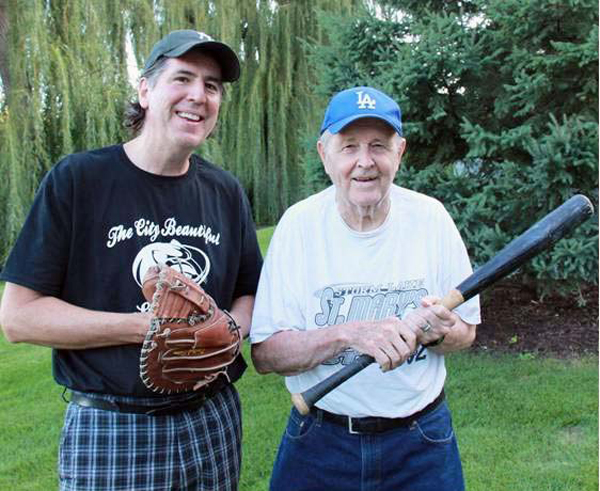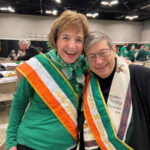Book Review by Barb Arland-Fye
“Fathers, Sons, and the Holy Ghosts of Baseball,” Beaver’s Pond Press, $17.95. Order it in your local bookstore.
Author Tommy Murray describes his novel about a Catholic Iowa high school baseball team’s quest to the finals as historical fiction. “All of the characters are people I knew very, very well.”

Author Tommy Murray and his dad, John.
Murray, a retired school teacher who lives in the Twin Cities, knows a thing or two about Iowa and baseball. He grew up in the state and is a 1974 graduate of one of our diocesan schools: Burlington Notre Dame. His dad, a school teacher who coached baseball outside the diocese, had visions of baseball stardom for his son, who stands 6-feet-5-inches tall. “Dad always associated height with athletic glory,” Murray says.
“I broke his heart. I was afraid of the ball,” admitted Murray, whose fear is reflected in one of the novel’s characters, Jeff. Fear, in fact, plays a subtle role in the lives of all of the characters in this slice-of-life tale set in the mythical town of Cottage Park, Iowa. The era, the 1970s, isn’t crucial to the story; it’s the time period of Murray’s teenage years. This story has been percolating in his mind since then.
“Fathers, Sons, and the Holy Ghosts of Baseball” pays homage to his dad’s love of baseball and to his uncle Tommy, an Iowa high school baseball champ who died in World War II. Uncle Tommy played in the first state championship baseball game in which Iowa private high schools could compete against public schools. Tommy’s school, St. John in Bancroft, defeated Atkins High School in 1943.
“He pitched in that game. He struck out 11 batters, stole a couple of bases and got a couple of hits,” Murray said. He was a baseball hero, but wanted to be a war hero, and ultimately lost his life serving the country he loved — just before the war’s end in 1945. Bancroft Memorial Baseball Park opened for play in 1948 on land in part donated by Murray’s grandfather. The ballpark is featured as the cover illustration of “Fathers, Sons, and the Holy Ghosts of Baseball.”
Paradoxically, the story opens with 14-year-old “T.J.,” a misfit from out of town with absolutely no interest in playing baseball. We meet him on the first of 59 days counting down to the finals. T.J. feels out of place and rightly so. “Praying and playing baseball are two of the town’s primary activities. Actually they are one in the same in a town where baseball is a religion,” a synopsis of the book reads.
T.J. is a composite of some of the troubled children Murray taught early in his teaching career. “At every place I went there was always one big fat white kid with a pimply complexion, stray thin hair and braces. The rest of the kids were ‘pin ball’ people. They were the tough kids and battled each other, except for this big white kid. I always wondered, ‘What did that kid do to get in here? I always swore I’d have a prototype of that character in my story.”
Keeping track of all of the characters — the team’s players, parents, siblings, the coaches and their spouses, and other assorted people — seemed challenging, initially. But I grew to appreciate the protagonists and their back stories, which put flesh on their bones. “Fathers, Sons, and the Holy Ghosts of Baseball” is not exactly a coming of age story. How can it be when three of the main characters — the coach and his two assistants — are elderly men; one of them a priest? Their back stories made me care about them, and understand their stubborn resistance to letting go.
Stories within the story make this novel a worthwhile read whether or not you enjoy baseball. Three of the side stories perturbed me: the brawl at “The Lipstick,” a terrifying incident involving T.J. and assistant coach “Egg,” and a confrontation between player Anthony Civilla and his father. These scenes placed vulnerable individuals in a precarious position. Sadly, that’s true to life.
The story’s finale, on the other hand, is a grand slam. Murray cleverly ties together all of the loose ends and delivers a message of faith and redemption.











